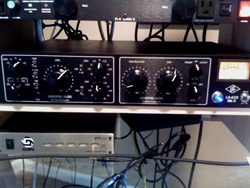If you’ve been recording for any length of time, you’ve more than likely come across a channel strip, or you will some day.
What is it?
A channel strip is simply an outboard microphone preamp that has either EQ or compression built in, or both.
These can be amazing tools, because you can begin to shape the sound of your recordings before the audio ever hits your recording software.
For example, you can use the EQ to tweak some of the low-mid frequencies that are muddying up the sound. And you can use a little bit of compression to keep the signal from clipping your converter.
Of course, you can go over-the-top, too, by dialing in some very dramatic settings.
However, with the added features availed by this tool comes an increased chance that something might go awry in tracking.
So here are three warnings for those of you using channel strips or thinking about buying one.
Difficulty Controlling Clipping
Most channel strips (like the once pictured above) have some sort of meter on them. The problem, though, is that the signal is going through several different gain stages.
There’s the input gain (preamp), there’s the gain on the EQ and/or compressor, and then there’s the output gain. Unfortunately you can only meter one of these at a time.
So, if you’re watching the meter for the output gain, and it appears to be well below clipping, you could still be clipping the signal on the preamp. The reason it’s not showing up on the output meter could be because the compressor is turning the signal down before it hits the output.
You can see how this could quickly become problematic. Clipping and distortion can be desirable on occasion, but usually you want to avoid them. The best way to do that with a channel strip is to be conservative. Don’t be quite as aggressive with the amount of gain you’re adding at each stage.
Most importantly, use your ears. Listen for any clipping/distortion in the audio. If something sounds off, stop recording and figure it out before it’s too late.
No Undo Button
Let’s say you record the perfect performance, only to realize that you added way too much compression to the signal. That’s not something you can undo in Pro Tools.
Once an effect has been printed done, it’s done. You’ll have to either live with it or record the part again.
The same is true with EQ. Maybe you thought boosting 60 Hz by 9 dB was a good idea at the time, but afterwards you could be regretting it. EQ can be a little more forgiving, because you can go in with an EQ plug-in and do a cut at 60Hz, but it’s not going to sound as natural as it would have without the original boost.
More Distractions Can Be Bad
A channel strip can quickly kill the mood of a session. If you’re constantly stopping the recording to tweak a knob or adjust a setting, the musician might get annoyed.
Or worse yet, the musician will be worn out and tired by the time you’re ready to record. When it doubt, keep it simple. Bypass the EQ and compressor and just get a nice, clean sound.
Don’t get me wrong, I love a good channel strip. Pictured above is the Universal Audio LA610 I borrowed to record vocals for a recent session, which sounded amazing.
Personally, I’d recommend getting (or trying out) a channel strip at some point when you have the opportunity. you can.
Have an opinion on channel strips? Let me know in the comments below!
Joe Gilder is a Nashville based engineer, musician, and producer who also provides training and advice at the Home Studio Corner.





















